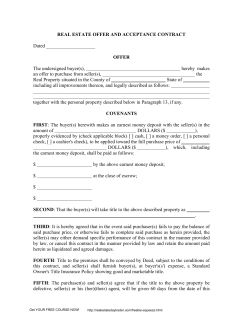
How To Prepare Your Company For Sale (With Due Diligence Checklist)
How To Prepare Your Company For Sale (With Due Diligence Checklist) Stuart M. Horwitz and Jason S. Damicone Planning ahead will pay off in the long run. Stuart M. Horwitz, the founding member of the Horwitz Group, LLC, has over 28 years of corporate, tax, estate, probate and succession planning experience. He is one of only five attorneys in the state of Ohio, and the only attorney in northeast Ohio, to be a Board Certified Specialist in Federal Taxation and Estate Planning, Trust and Probate. Mr. Horwitz uses the latest techniques in his practice including many techniques developed in-house. He can be reached at stu@ thglawfirm.com. Jason S. Damicone an Associate with the Horwitz Group, has 10 years of tax and estate planning experience. During his career, he has gained experience in the areas of corporate/business transactions, corporate/business planning, taxation, estate planning, probate and trust administration. His extensive educational background in taxation has been instrumental in allowing him to meet the challenging business and personal planning demands of his clients. He can be reached at jason@thglawfirm.com. IT IS NEVER TOO EARLY to start planning for the eventual sale of your company. While this article will not explain every step that should be taken, the purpose is to give the reader a general framework for moving forward. Step One: Identify The Price You should obtain a valuation. From a strategic bargaining standpoint, your detailed valuation can serve as a negotiating chip with a buyer. It’s one thing to say, “I think my company is worth ‘x’.” It’s another thing to have backup that can ultimately be shared with a prospective purchaser. Step Two: Identify The Type Of Buyer There are two types of buyer: the strategic buyer and the financial buyer. A strategic buyer is buying your business because you have something that will enhance its business. For example, a competitor of yours would be a strategic buyer as it would be buying your customer lists and/or methodologies. A strategic buyer would not keep your administrative staff, since this would amount to redundant personnel; this buyer would also keep fewer employees generally. A financial buyer is purchasing your business because of your annual profit. Why is it important to differentiThe Practical Lawyer | 31 32 | The Practical Lawyer ate? A financial buyer will pay one multiple of your EBIT or EBITDA; whereas a strategic buyer will pay a much higher multiple and may even base its upper-end offer on its (i.e., buyer’s) ultimate profit using your key information/goods. In most cases, the price will be set early in the process. If you try and negotiate a higher price later, there will be significant pushback from the buyer and you may end up losing the deal. Most sellers only get one chance to cash out; so it is important to have all your ducks in a row at the beginning of the negotiations. Step Three: Make Sure Your Business Is Structured Properly Depending on the type of entity you have, you may want to tweak the structure. For example, if you are a Subchapter C corporation you may want to convert to a Subchapter S corporation. This could result in a significant reduction in income taxes upon sale. Most counselors will tell you a conversion will be ineffectual if you end up selling within 10 years (the general rule is that any conversion within 10 years of the sale date will be ignored and there will be two levels of tax); however there is an exception to this rule. Any appreciation after the date of the conversion will only be subject to one level of tax. For example, if your business was worth $5 million in 2013 (and you elect S Corp status) and you end up selling your company in 2015 for $8 million, the difference ($3 million) is only subject to a single level of tax. In order to buttress your argument we advise that you obtain a valuation at the time of the conversion. There are other steps that can be taken; creativity is your only limiter. For example, we sometimes recommend that a C Corporation contribute its assets to a limited liability company and convert the C Corporation to an S Corporation. This more complex restructuring can provide many benefits. First, if you want to bring in outside investors, this special structure can provide for a single level of tax on op- February 2014 erating income going forward and give you the latitude to bring in a diverse group of investors (LLCs taxed as partnerships are much more flexible than S Corporations). Second, if you want to incent key employees, you can have the LLC issue a special type of equity ownership known as a “profits interest.” This is a very versatile planning technique that is often overlooked. Third, if you decide to retain your company, this structure can maximize your flexibility in operating your business. There are numerous issues in setting up this type of structure so you should consult with a tax attorney. Even if you are an LLC taxed as a partnership or an S Corporation, there could still be structuring issues. For example, if you are an LLC taxed as a partnership now, you may want to consider switching to an S Corporation if you would be operating the company for a number of years. You could save significant dollars relating to the social security tax from such a conversion. If you are an S Corporation, you may still want to adopt the LLC subsidiary structure discussed above. This would give you more latitude in bringing in investors and/or rewarding key employees. Step Four: Perform Due Diligence — Now! Deals tend to fail when the buyer is surprised. The best way to avoid surprises is to anticipate a buyer’s questions/requests. Fortunately, this is a relatively straightforward process. Attached to the end of this article is a due diligence checklist. We recommend that you review all of the issues and address/fix the issues before engaging in any discussions with a prospective buyer. There are certain major issues in any due diligence review. First, make sure your key employees are locked up with employment/non-compete agreements. If the purchaser is a financial buyer it may be concerned about the company’s continued viability should certain key employees leave. Second, if there are any outstanding or threatened claims, this could cause a buyer to withdraw or at Preparing Your Company for Sale | 33 least require a substantial escrow until the claim is resolved. Third, if you have taken any aggressive positions on your returns or financial statements you should address them now. Fourth, whether you are a corporation, partnership or LLC, you should get your company’s internal documents updated. For example, a corporation should have a current minute-book with all necessary actions approved by the shareholders and directors. A partnership or LLC should have current a current partnership agreement or operating agreement, as the case may be. Fifth, you should check on all licenses and compliances. If you are in any way non-compliant, the deal can be held up, so it is a good idea to fix it now. Rest assured, in a stock deal there will be a representation and warranty to this. This would also include any “license to do business” in other states. Sales and use tax issues may be a particular concern. Sixth, it is important to address any nonqualified or qualified plan issues well before a sale as these problems generally take a while to remedy. Seventh, you should review all material contracts as well as your relationships with your suppliers, distributors and customers. Problems with any of these topics can delay a closing; or worse. Step Five: Crunch The Numbers And Determine Your After-Tax Takeaway From A Stock Or Asset Deal An acquiring company will generally either purchase your shares of stock (or LLC/partnership interest) or all of your assets. While most sellers want to sell their stock, most buyers want to purchase all the assets of the seller. Sellers like to sell shares as this gives the seller capital gain and the seller does not have to worry about any wrap-up of the company as the buyer continues on with the company. The buyer generally wants to purchase all of the seller’s assets as this gives the buyer a “step up” in the basis of all the items purchased; thereby allowing for maximum depreciation. Further, by purchasing assets, a buyer can generally obtain a fresh start, from a liability perspective. It is imperative that you know what your tax rates will be, as this will dictate what your target purchase price needs to be. Step Six: Protect Your Company This can be the critical step in any sale. You should have a confidentiality agreement ready for the prospective purchasers. In addition to addressing outside parties, you need to address inside parties — the employees. It is advisable to minimize any contacts between buyers and employees. If the buyer(s) is a strategic buyer, you may have a mass exodus of employees if they discover you are “shopping the company.” Finally, even if the buyer signs a confidentiality agreement, you should try and maintain/protect your trade secrets regardless. While a confidentiality agreement is called for, it is not perfect. Remember — other than litigation attorneys, who would be happy about engaging in a protracted lawsuit against a buyer who violated the confidentiality agreement? Step Seven: Protect Yourself And Your Profits There are numerous ways you can lose your money: • Indemnity. If you are a manufacturing concern, buyers will generally require that you indemnify them for any claims arising prior to the acquisition date. To circumvent this problem, you should see if you can be named as a co-insured on any products liability insurance that the buyer will carry. If this is not an option, then you should look at tail policies to cover the indemnification period (usually five years); • Escrow. Another critical deal point is the escrow/holdback. Get as much money up front as the escrow may never be paid; • Carve off non-business and certain other assets. If you want to retain anything held in the company, you can distribute them now (i.e. insur-
© Copyright 2025







![[ ] MARINE PURCHASE AGREEMENT INSERT COMPANY HEADER](http://cdn1.abcdocz.com/store/data/000044411_2-38ec39dae7ad3387f14379136046af82-250x500.png)






